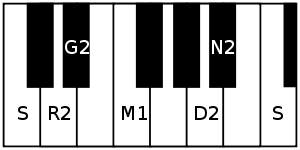Shree ranjani
Shree ranjani is a rāgam in Carnatic music (musical scale of South Indian classical music). It is a hexatonic scale (shadava rāgam, which means "of six"). It is a derived scale (janya rāgam), as it does not have all the seven swaras (musical notes). It is also written as Shri ranjani or Sriranjani.
| Arohanam | S R₂ G₂ M₁ D₂ N₂ Ṡ |
|---|---|
| Avarohanam | Ṡ N₂ D₂ M₁ G₂ R₂ S |
| Carnatic music |
|---|
Tanjavur-style Tambura |
| Concepts |
| Compositions |
| Instruments |
|
Structure and Lakshana

Shree ranjani is a symmetric scale that does not contain panchamam. It is called a shadava-shadava rāgam,[1][2] in Carnatic music classification (as it has six notes in both ascending and descending scales). Its ārohaṇa-avarohaṇa structure is as follows (see swaras in Carnatic music for details on below notation and terms):
- ārohaṇa : S R₂ G₂ M₁ D₂ N₂ Ṡ[lower-alpha 1]
- avarohaṇa : Ṡ N₂ D₂ M₁ G₂ R₂ S[lower-alpha 2]
This scale uses the notes shadjam, chathusruti rishabham, sadharana gandharam, shuddha madhyamam, chathusruthi dhaivatham and kaisiki nishadam. Shree ranjani is a janya rāgam of Kharaharapriya, the 22nd Melakarta rāgam. It has only the invariant panchamam missing from its parent scale, Kharaharapriya.
Popular compositions
Shree ranjani is a pleasing and popular rāgam.[2] This scale has been used by many composers and there are many compositions in classical music. It has been used to score film music, too. Here are some popular compositions in Sriranjani.
- Marubalka, Brochevarevare, Sari evvare, Bhuvini daasudane, and Sogasuga mrudanga talamu by Thyagaraja
- Ni sati deivamu,Balambikaye and parvata raja kumari by Muthuswami Dikshitar
- Ini oru kanam unnai, Kaana Vendamo and Gajavadana karuna by Papanasam Sivan
- Srinivasa Enna Bittu by Purandaradasa
- Nadhamennum Kovilile by M S Viswanathan rendered by Vani Jayaram
- Pagalile Oru Nilavinai Kanden by Ilayaraaja rendered by S. Janaki
- Mukshika Vahanane by Manachanallur Giridharan rendered by Harini
Film Songs
Language: Tamil
| Song | Movie | Composer | Singer |
|---|---|---|---|
| Naathamenum Kovililey | Manmadha Leelai | M. S. Viswanathan | Vani Jairam |
| Nathavinothangal | Salangai Oli | Ilaiyaraaja | S. P. Balasubramanyam,S. P. Sailaja |
| Naatham Elunthathadi | Gopura Vasalile | K. J. Yesudas,S. Janaki | |
| Oru Raagam | Unnai Vaazhthi Paadugiren | ||
| Oru Manthara poo | Chinna Jameen | Mano,K. S. Chitra | |
| Vanthadhu Vanthadhu | Kilipetchu Ketkava | S. Janaki | |
| Pagalile Oru Nilavinai Kanden | Ninaive Oru Sangeetham | ||
| Chinnai Chiru | Endrum Anbudan | S. P. Balasubrahmanyam | |
| Vaikasi Vellikilama | Rasa Magan | ||
| Vennilavin Perai Matrava | Ramanaa | Hariharan,Sadhana Sargam | |
| Kannan Nee En | Ivan | Sudha Ragunathan | |
| Chinna Chinna Malaithullikal | En Swasa Kaatre | A. R. Rahman | M. G. Sreekumar |
| Kadavulidam | Azhagiya Pandipuram | Bharadwaj | Prasanna,Sadhana Sargam |
| Alaithal Varuvale | Jaathi Malli | Maragadha Mani | S. P. Balasubrahmanyam,K. S. Chitra |
Related rāgams
This section covers the theoretical and scientific aspect of this rāgam.
Scale similarities
- Ābhōgi is a rāgam which does not have the kaisiki nishadam in both ascending and descending scales in comparison to Sriranjani. Its ārohaṇa-avarohaṇa structure is S R₂ G₂ M₁ D₂ Ṡ: Ṡ D₂ M₁ G₂ R₂ S
- Ragam Jayamanohari is a ragam which is like Abhogi in ascending scale and like Sriranjani is descending scale. Its ārohaṇa-avarohaṇa structure is S R₂ G₂ M₁ D₂ Ṡ: Ṡ N₂ D₂ M₁ G₂ R₂ S[lower-alpha 3]
Notes
- Alternate notations:
- Hindustani: S R G̱ M D Ṉ Ṡ
- Western: C D E♭ F A B♭ C
- Alternate notations:
- Hindustani: Ṡ Ṉ D M G̱ R S
- Western: C B♭ A F E♭ D C
- Alternate notations:
- Hindustani: Ṡ Ṉ D M G̱ R S
- Western: C B♭ A F E♭ D C
References
- Ragas in Carnatic music by Dr. S. Bhagyalekshmy, Pub. 1990, CBH Publications
- Raganidhi by P. Subba Rao, Pub. 1964, The Music Academy of Madras